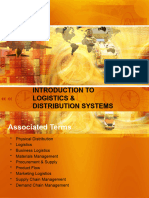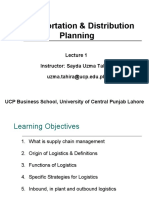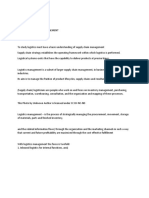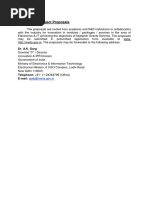0 ratings0% found this document useful (0 votes)
13 viewsLogistics
Mcom notes
Uploaded by
vasu pradeepCopyright
© © All Rights Reserved
Available Formats
Download as PDF or read online on Scribd
0 ratings0% found this document useful (0 votes)
13 viewsLogistics
Mcom notes
Uploaded by
vasu pradeepCopyright
© © All Rights Reserved
Available Formats
Download as PDF or read online on Scribd
You are on page 1/ 18
Logistics Defined
Logistics is the process of planning, implementing and
controlling the efficient, cost-effective flow and storage
of raw materials, in-process inventory, finished goods
and related information from the point of origin to point
of consumption for the purpose of conforming to
customer requirements.
Council of Logistics Management
Supply Chain Management Defined
SCM is the integration of all activities associated with the
flow and transformation of goods from raw materials
through to end user, as well as information flows, through
improved supply chain relationships, to achieve a
sustainable competitive advantage.
Handfield and Nichols
The Logistics/Supply Chain Mission
Getting the right goods or services t
the right place, at the right time, and 1
the desired condition at the lowest cos
and highest return on investment.
Evolution of Supply Chain Management
ty tinge td ct etgraton 196010 208 so00e
Demand forecasting
Purchasing
Requirements planning
Purchasing!
Materials
Management
Production planning
Manufacturing inventory
Warehousing
Logistics
‘Material handling
Packaging
Finished goods inventory
Physical
Distribution
‘Supply Chain
Management
Distribution planning
Order processing
“Transportation
Customer service
‘Svatege planning
Information serves
Markoting/sles
Finance
Effect on Logistics Outsourcing
Internal handling Outsourcing
Profit. | | Profit ————L increase
Marketing Market
arketing
Logistics
° Logistics ——| Lincrease }
Overhead Tariffs
Overhead
Materials
Materials
Tanon + Reduction
labor ———]
Scope of the Supply Chain for Most Firms
Business lo}
oo
Physical supply
(Materials management)
Physical distribution
Sources of
supply
a
—— |
Plants/
operations
‘Transportation
Inventory maintenance
Order processing
‘+ Acquisition/ Procurement
+ Protective packaging
'* Warehousing
Materials handling
‘Information maintenance
reo——aalip
_ a a
“Transportation
Inventory maintenance
* Order processing
Product scheduling
«Protective packaging
*Warehousing
Materials handling
Information maintenance
Focus firm’s internal supply chain
Customers
Key Activities/Processes
¢ Primary
- Setting customer service goals
- Transportation
- Inventory management
- Location
« Secondary, or supporting
- Warehousing
- Materials handling
- Acquisition (purchasing)
- Protective packaging
- Product scheduling
- Order processing
The Logistics Strategy Triangle
Inventory Strategy
« Forecasting
« Storage fundamentals
« Inventory decisions
Purchasing and supply
scheduling decisions,
« Storage decisions
Transport Strategy
Transport fundamentals
« Transport decisions
‘Customer
service goals
© The product
* Logistics servi
© Information sys.
Location Strategy
+ Location decisions
« The network planning process
Strategic, Tactical, and Operational Decision Making
Decision area Strategic Tactical Operational
Transportation Mode selection Seasonal equip- _Dispatching
ment leasing
Inventories Location, Control policies Safety stock levels Order filling
Order Order entry, transmittal, Processing
processing and processing system orders, Filling
design back orders
Purchasing Development of supplier- Contracting, Expediting
buyer relations Forward buying
Warehousing Handling equipment Space utilization Order picking
selection, Layout design and restocking
Facility Number, size, and
location location of warehouses
27
Integrated Logistics Systems (ILS)
* ILS is used by many firms, with the help of
Information Technology for tracking and coordinating
the following functions effectively:
— Material management
— Material flow systems
— Physical distribution
* Volvo operates their warehouse in Memphis with the
support of third party suppliers, FedEx Logistics
Services, to handle stocks of truck parts. If a Volvo
dealer needed a part in an emergency, phones a toll-free
number and the part is flown out the same day and
delivered that night at either the airport or the dealer’s
office.
Market Logistics Objectives
Situations where logistics planning may go wrong:
The Traffic/ Logistics manager favours rail shipment over air shipment
because of the less rail cost. However, because the rail transport are slower,
it ties up working capital longer, delay customer payment, and might cause
customers to buy from competitors who offer faster service.
The Shipping department uses cheap containers to minimize shipping
costs. Cheaper containers lead to a higher rate of damaged goods.
The Inventory manager favours low inventory. This increases the
possibility of ‘stockouts’, back orders, huge paperwork etc.
Major objectives for any company logistics planning:
On-time delivery
Effectively meet emergency needs
Careful handling of merchandise
Willingness to take back defective goods and resupply them quickly.
Indian Logistic System: Scenario
IndustryOverview
* Logistics functions are currently an in-house activity for
companies that Aire discrete services such as transportation and
warehousing while internally performing order processing, distribution,
and Logistics planning for inbound and outbound logistics.
* Outsourcing of entire logistics to third-party logistics service
providers is highly limited.
* The practice of complete logistics outsourcing is recent in
India with multinational companies being the major users of
this service.
Indian Logistic System: Scenario
* The logistics industry in India is highly fragmented.
This is mainly due to the nature of the
transportation industry.
* In India, over 50 percent of goods are transported
by road. The road transport sector is highly
fragmented with vehicle ownership firmly in the
hands of individual trucks owners with 67 percent
of the owners with a fleet of less than five vehicles.
Indian Logistic Scenario
* Inventory carrying costs account for approximately
24 percent of the logistics cost.
* Order processing and administrative costs account
for a significant 10 percent of the logistics costs.
* Stock filing and warehouse management in many cases is
done manually increasing the administrative costs at the
same time adding an element of inefficiency in warehouse
management.
Indian Logistic Scenario
* Companies in India are slowly moving towards total
outsourcing of logistics that provides access to
logistics services to their production facility,
warehouses, and IT systems.
¢ Ahigh level of integration is required between the
company and logistics service providers to provide
logistics services that fulfill the strategic objective of
the companies.
Indian Logistic Structure
* The total logistics market consists of market participants
from the unorganized seqment to highly technology savvy
and process driven service providers with high levels of
expertise in the area of logistics management.
* The market participants in this industry can be broadly
classified into three broad seqments, namely:
— Pure transporters
— Integrated transporters with warehousing facilities
— Third-party logistics service providers (3PLs)
Pure & Integrated Transporters
* Transporters are involved only in the physical
movement of goods. They can be classified as
— small, medium and large based on the ownership
pattern of vehicles and their revenue.
* Transporters are considered to be highly
unorganized although many large transporters form
a part of the organized segment of the market.
* Many large transporters are diversifying their
operations to include total logistics management.
Indian Supply Chain Scenario
Some Facts
* GDP : Rs. 27.55 Lakh Crores*
* Inventory tied up : Rs. 1.17 Lakh Crores
* Logistics Cost : 14% of our GDP
* 1% Reduction inLC —: Rs. 27550 Crores
* 2% Reduction inLC —: Rs. 55100 Crores
* Economic Survey 2003-04
Elements of Logistics cost
* Transportation 35%
* Inventories 25%
* Losses 14%
* Packaging 11%
* Handling and Warehousing 9%
* Customers’ shopping 6%
You might also like
- Transportation & Distribution Planning: Instructor: Sayda Uzma Tahira Uzma - Tahira@ucp - Edu.pkNo ratings yetTransportation & Distribution Planning: Instructor: Sayda Uzma Tahira Uzma - Tahira@ucp - Edu.pk27 pages
- Logistics: Prepared By: Shah Ridwan ChowdhuryNo ratings yetLogistics: Prepared By: Shah Ridwan Chowdhury24 pages
- Logistics and Supply Chain Management Logistics and Supply Chain ManagementNo ratings yetLogistics and Supply Chain Management Logistics and Supply Chain Management45 pages
- Presentation 1 (VPA) Supply Chain ManagementNo ratings yetPresentation 1 (VPA) Supply Chain Management240 pages
- Department of Management Studies, BSA Crescent Institute of Science & TechnologyNo ratings yetDepartment of Management Studies, BSA Crescent Institute of Science & Technology32 pages
- Chapter 2 - Overview of Logistics Management - Introduction to Logistics and SCM (1)No ratings yetChapter 2 - Overview of Logistics Management - Introduction to Logistics and SCM (1)40 pages
- Fundamentals of Logistics and Supply Chain Management0% (2)Fundamentals of Logistics and Supply Chain Management17 pages
- Chapter 2 - Overview of Logistics Management - Introduction to Logistics and SCMNo ratings yetChapter 2 - Overview of Logistics Management - Introduction to Logistics and SCM40 pages
- Chapter 1 Ovcerview of Buss Logistics and PlanningNo ratings yetChapter 1 Ovcerview of Buss Logistics and Planning26 pages
- Basic of Logistics Management - 1553484948 PDF100% (1)Basic of Logistics Management - 1553484948 PDF34 pages
- Concepts in International Logistics Management-Prince Dudhatra-9724949948No ratings yetConcepts in International Logistics Management-Prince Dudhatra-972494994816 pages
- Introduction To Retail Management Module 1100% (1)Introduction To Retail Management Module 152 pages
- Introduction To Supply Chain Management: Dr. Rachna Gangwar TAPMI School of Business, JaipurNo ratings yetIntroduction To Supply Chain Management: Dr. Rachna Gangwar TAPMI School of Business, Jaipur85 pages
- Information-Systems-and-Supply-Chain-Management-1-2048No ratings yetInformation-Systems-and-Supply-Chain-Management-1-204821 pages
- International Monetary System: DR Sowmya SNo ratings yetInternational Monetary System: DR Sowmya S22 pages
- Transportation & Distribution Planning: Instructor: Sayda Uzma Tahira Uzma - Tahira@ucp - Edu.pkTransportation & Distribution Planning: Instructor: Sayda Uzma Tahira Uzma - Tahira@ucp - Edu.pk
- Logistics and Supply Chain Management Logistics and Supply Chain ManagementLogistics and Supply Chain Management Logistics and Supply Chain Management
- Department of Management Studies, BSA Crescent Institute of Science & TechnologyDepartment of Management Studies, BSA Crescent Institute of Science & Technology
- Chapter 2 - Overview of Logistics Management - Introduction to Logistics and SCM (1)Chapter 2 - Overview of Logistics Management - Introduction to Logistics and SCM (1)
- Fundamentals of Logistics and Supply Chain ManagementFundamentals of Logistics and Supply Chain Management
- Chapter 2 - Overview of Logistics Management - Introduction to Logistics and SCMChapter 2 - Overview of Logistics Management - Introduction to Logistics and SCM
- Chapter 1 Ovcerview of Buss Logistics and PlanningChapter 1 Ovcerview of Buss Logistics and Planning
- Concepts in International Logistics Management-Prince Dudhatra-9724949948Concepts in International Logistics Management-Prince Dudhatra-9724949948
- Introduction To Supply Chain Management: Dr. Rachna Gangwar TAPMI School of Business, JaipurIntroduction To Supply Chain Management: Dr. Rachna Gangwar TAPMI School of Business, Jaipur
- Information-Systems-and-Supply-Chain-Management-1-2048Information-Systems-and-Supply-Chain-Management-1-2048








































































